Swarm Intelligence-Based Methodology for Scanning Electron Microscope Image Segmentation of Solid Oxide Fuel Cell Anode
Abstract
1. Introduction
2. Methodology
2.1. Image Acquisition
2.2. Images Filtering
- Preliminary filtering:
- 1.1.
- Apply 2D median filtering with 3 × 3 window
- 1.2.
- Adjust image intensity by mapping into range 0 to 1
- Sharpen preliminary image with Unsharp masking
- Make mask by finding edges using the Canny edge detection algorithm [37]
- Dilate the mask with a disk-shaped structuring element (the radius r = 3)
- Apply Gaussian filter on preliminary image to smooth the image and adjust image intensity
- Merge sharpened and smoothed images using mask in following manner:
- 6.1.
- Fill masked region from sharpened image
- 6.2.
- Fill rest of image with smoothed image
- Repeat the preliminary filtering procedure.
| Algorithm 1 Filter optimization algorithm. |
|
2.3. Image Segmentation
- Should be inside the region and near the center of the region;
- Assuming most of the pixels in the region of interest (ROI) belong to the region (i.e., ROI is not too big compared to the region), the feature of this seed point should be close to the region average;
- The distances from the seed pixel to its neighbors should be small enough to allow continuous growing [47].
- Image is initially segmented with the fast automatic segmentation method (we have used Multithresholding);
- For each phase, perform one iteration of image erosion;
- For each phase, define seeds as centers of mass of each separated region.
| Algorithm 2 SRG optimization algorithm. |
|
3. Results
4. Conclusions
Author Contributions
Funding
Institutional Review Board Statement
Informed Consent Statement
Data Availability Statement
Conflicts of Interest
Sample Availability
Abbreviations
| GDC | Gadolinium-Doped Ceria |
| FIB | Focused Ion Beam |
| LSCF | Lanthanum Strontium Cobalt Ferrite |
| MCR | MisClassification Ratio |
| MSE | Mean Squared Error |
| PSO | Particle Swarm Optimization |
| ROI | Region Of Interest |
| SAD | Sum of Absolute Differences |
| SEM | Scanning Electron Microscope |
| SLIC | Simple Linear Iterative Clustering |
| SOFC | Solid Oxide Fuel Cell |
| SRG | Seeded Region Growing |
| SSIM | Structural Similarity Index Measure |
| YSZ | Yttria-Stabilized Zirconia |
References
- Pajak, M.; Buchaniec, S.; Kimijima, S.; Szmyd, J.S.; Brus, G. A multiobjective optimization of a catalyst distribution in a methane/steam reforming reactor using a genetic algorithm. Int. J. Hydrog. Energy 2020. in Press. [Google Scholar] [CrossRef]
- Tomiczek, M.; Kaczmarczyk, R.; Mozdzierz, M.; Brus, G. A numerical analysis of heat and mass transfer during the steam reforming process of ethane. Heat Mass Transf. 2017, 54, 2305–2314. [Google Scholar] [CrossRef]
- Pethaiah, S.S.; Sadasivuni, K.K.; Jayakumar, A.; Ponnamma, D.; Tiwary, C.S.; Sasikumar, G. Methanol Electrolysis for Hydrogen Production Using Polymer Electrolyte Membrane: A Mini-Review. Energies 2020, 13, 5879. [Google Scholar] [CrossRef]
- Prokop, T.; Berent, K.; Szmyd, J.S.; Brus, G. A Three-Dimensional Numerical Assessment of Heterogeneity Impact on a Solid Oxide Fuel Cell’s Anode Performance. Catalysts 2018, 8, 503. [Google Scholar] [CrossRef]
- Prokop, T.A.; Brus, G.; Kimijima, S.; Szmyd, J.S. Thin Solid Film Electrolyte and Its Impact on Electrode Polarization in Solid Oxide Fuel Cells Studied by Three-Dimensional Microstructure-Scale Numerical Simulation. Energies 2020, 13, 5127. [Google Scholar] [CrossRef]
- Brus, G.; Miyoshi, K.; Iwai, H.; Saito, M.; Yoshida, H. Change of an anode’s microstructure morphology during the fuel starvation of an anode-supported solid oxide fuel cell. Int. J. Hydrog. Energy 2015, 40, 6927–6934. [Google Scholar] [CrossRef]
- Iwai, H.; Shikazono, N.; Matsui, T.; Teshima, H.; Kishimoto, M.; Kishida, R.; Hayashi, D.; Matsuzaki, K.; Daisuke, K.; Motohiro, S.; et al. Quantification of SOFC anode microstructure based on dual beam FIB-SEM technique. J. Power Sources 2010, 195, 955–961. [Google Scholar] [CrossRef]
- Wilson, J.R.; Kobsiriphat, W.; Mendoza, R.; Chen, H.Y.; Hiller, J.M.; Miller, D.J.; Thornton, K.; Voorhees, P.W.; Adler, S.B.; Barnett, S.A. Three-dimensional reconstruction of a solid-oxide fuel-cell anode. Nat. Mater. 2006, 5, 541–544. [Google Scholar] [CrossRef]
- Joos, J.; Carraro, T.; Weber, A.; Ivers-Tiffee, E. Reconstruction of porous electrodes by FIB/SEM for detailed microstructure modeling. J. Power Sources 2011, 196, 7302–7307. [Google Scholar] [CrossRef]
- Prokop, T.A.; Berent, K.; Iwai, H.; Szmyd, J.S. A three-dimensional heterogeneity analysis of electrochemical energy conversion in SOFC anodes using electron nanotomography and mathematical modeling. Int. J. Hydrog. Energy 2018, 43, 10016–10030. [Google Scholar] [CrossRef]
- Wilson, J.R.; Gameiro, M.; Mischaikow, K.; Kalies, W.; Voorhees, P.W.; Barnett, S.A. Three-Dimensional Analysis of Solid Oxide Fuel Cell Ni-YSZ Anode Interconnectivity. Microsc. Microanal. 2009, 15, 71–77. [Google Scholar] [CrossRef] [PubMed][Green Version]
- Kishimoto, M.; Iwai, H.; Saito, M.; Yoshida, H. Quantitative evaluation of solid oxide fuel cell porous anode microstructure based on focused ion beam and scanning electron microscope technique and prediction of anode overpotentials. J. Power Sources 2011, 196, 4555–4563. [Google Scholar] [CrossRef]
- Brus, G.; Iwai, H.; Sciazko, A.; Saito, M.; Yoshida, H.; Szmyd, J.S. Local evolution of anode microstructure morphology in a solid oxide fuel cell after long-term stack operation. J. Power Sources 2015, 288, 199–205. [Google Scholar] [CrossRef]
- Jiao, Z.; Shikazono, N. 3D reconstruction size effect on the quantification of solid oxide fuel cell nickel–yttria-stabilized-zirconia anode microstructural information using scanning electron microscopy-focused ion beam technique. Eng. Sci. 2016, 61, 1317–1323. [Google Scholar] [CrossRef]
- Bertei, A.; Ruiz-Trejo, E.; Kareh, K.; Yufit, V.; Wang, X.; Tariq, F.; Brandon, N.P. The fractal nature of the three-phase boundary—A heuristic approach to the degradation of nanostructured solid oxide fuel cell anodes. Nano Energy 2017, 38, 526–536. [Google Scholar] [CrossRef]
- Jorgensen, P.S.; Bowen, J.R. Automatic Quantitative Image Analysis of Micrographs. In Proceedings of the European SOFC and SOE Forum, Lucern, Switzerland, 3–6 July 2008. [Google Scholar]
- Mary, J.M. Image segmentation technique-a study on region growing approaches. Int. J. Sci. Res. Comput. Sci. 2017, 2, 7–10. [Google Scholar]
- Russ, J.C. The Image Processing Handbook, 5th ed.; CRC Press: Boca Raton, FL, USA, 2006. [Google Scholar] [CrossRef]
- Jorgensen, P.S.; Hansen, K.V.; Larsen, R.; Bowen, J.R. A framework for automatic segmentation in three dimensions of microstructural tomography data. Ultramicroscopy 2010, 110, 216–228. [Google Scholar] [CrossRef]
- Mozdzierz, M.; Berent, K.; Kimijima, S.; Szmyd, J.S.; Brus, G. A Multiscale Approach to the Numerical Simulation of the Solid Oxide Fuel Cell. Catalysts 2019, 9, 253. [Google Scholar] [CrossRef]
- Schindelin, J.; Arganda-Carreras, I.; Frise, E.; Kaynig, V.; Longair, M.; Pietzsch, T.; Preibisch, S.; Rueden, C.; Saalfeld, S.; Schmid, B.; et al. Fiji: An open-source platform for biological-image analysis. Nat. Methods 2012, 9. [Google Scholar] [CrossRef]
- Rueden, C.T.; Schindelin, J.; Hiner, M.C.; DeZonia, B.E.; Walter, A.E.; Arena, E.T.; Eliceiri, K.W. ImageJ2: ImageJ for the next generation of scientific image data. BMC Bioinform. 2017, 18, 1–26. [Google Scholar] [CrossRef]
- Sciazko, A.; Komatsu, Y.; Shimura, T.; Shikazono, N. Segmentation of Solid Oxide Cell Electrodes by Patch Convolutional Neural Network. J. Electrochem. Soc. 2021, 168, 044504. [Google Scholar] [CrossRef]
- Law, T.Y.; Heng, P. Automated extraction of bronchus from 3D CT images of lung based on genetic algorithm and 3D region growing. Proc. SPIE 2000, 3979, 906–916. [Google Scholar] [CrossRef]
- Whitney, B.W.; Backman, N.J.; Furst, J.D.; Raicu, D.S. Single click volumetric segmentation of abdominal organs in Computed Tomography images. Proc. SPIE 2000, 6144, 61444G-1. [Google Scholar] [CrossRef]
- Feng, Q.; Gao, B.; Lu, P.; Woo, W.; Yang, Y.; Fan, Y.; Qiu, X.; Gu, L. Automatic seeded region growing for thermography debonding detection of CFRP. NDT E Int. 2018, 99, 36–49. [Google Scholar] [CrossRef]
- Yang, X.; Fu, X.; Li, X. Adaptive Clustering SOFC Image Segmentation Based on Particle Swarm Optimization. IOP Conf. Ser. J. Phys. 2020, 1229, 18859–18881. [Google Scholar] [CrossRef]
- Fu, X.; Yang, X.; Guo, C.; Li, X. Noise suppressed and bias field corrected image segmentation method for porous Ni-YSZ anode microstructure. Multimed. Tools Appl. 2020, 79, 012020. [Google Scholar] [CrossRef]
- Eberhart, R.; Kennedy, J. A new optimizer using particle swarm theory. In Proceedings of the Sixth International Symposium on Micro Machine and Human Science, Nagoya, Japan, 4–6 October 1995; pp. 39–43. [Google Scholar] [CrossRef]
- Kachitvichyanukul, V. Comparison of Three Evolutionary Algorithms: GA, PSO, and DE. Ind. Eng. Manag. Syst. 2012, 11, 215–223. [Google Scholar] [CrossRef]
- Lech, S.; Kruk, A.; Gil, A.; Cempura, G.; Agüero, A.; Czyrska-Filemonowicz, A. Three-dimensional imaging and characterization of the oxide scale formed on a polycrystalline nickel-based superalloy. Scr. Mater. 2019, 167, 16–20. [Google Scholar] [CrossRef]
- Jiao, Z.; Shikazono, N.; Kasagi, N. Quantitative characterization of SOFC nickel-YSZ anode microstructure degradation based on focused-ion-beam 3D-reconstruction technique. J. Electrochem. Soc. 2012, 159, B285–B291. [Google Scholar] [CrossRef]
- Sciazko, A.; Miyahara, K.; Komatsu, Y.; Shimura, T.; Jiao, Z.; Shikazono, N. Influence of Initial Powder Morphology on Polarization Characteristics of Nickel/Gadolinium-Doped-Ceria Solid Oxide Fuel Cells Electrode. J. Electrochem. Soc. 2019, 166, F44–F52. [Google Scholar] [CrossRef]
- Brus, G.; Iwai, H.; Szmyd, J.S. An Anisotropic Microstructure Evolution in a Solid Oxide Fuel Cell Anode. Nanoscale Res. Lett. 2020, 15, 427. [Google Scholar] [CrossRef]
- Wang, A.Z.; Bovik, H.C.; Sheikh, R.; Simoncelli, E.P. Image quality assessment: From error visibility to structural similarity. IEEE Trans. Image Process. 2004, 13. [Google Scholar] [CrossRef] [PubMed]
- Hast, A.; Marchetti, A. Improved illumination correction that preserves medium-sized objects. Mach. Graph. Visions 2014, 23, 3–20. [Google Scholar]
- Canny, J. A Computational Approach to Edge Detection. IEEE Trans. Pattern Anal. Mach. Intell. 1986, PAMI-8, 679–698. [Google Scholar] [CrossRef]
- The MathWorks, Inc. Adjust Image Intensity Values or Color Map. 2020. Available online: https://www.mathworks.com/help/images/ref/imadjust.html (accessed on 25 August 2020).
- Hast, A.; Marchetti, A. Retrospective Illumination Correction of Greyscale Historical Aerial Photos. Image Anal. Process. Notes Comput. Sci. 2011, 6979. [Google Scholar] [CrossRef]
- Barnes, A. Kuwahara Filter. MATLAB Central File Exchange. Available online: https://www.mathworks.com/matlabcentral/fileexchange/8171-kuwahara-filter (accessed on 25 August 2020).
- Papari, G.; Petkov, N.; Campisi, P. Artistic Edge and Corner Enhancing Smoothing. IEEE Trans. Image Process. 2007, 16, 2449–2461. [Google Scholar] [CrossRef]
- Agarwal, R. Homomorphic Filter Using Matlab. Available online: http://thelearningsquare.in/image-processing/ (accessed on 25 August 2020).
- The MathWorks, Inc. Sharpen Image Using Unsharp Masking. 2020. Available online: https://www.mathworks.com/help/images/ref/imsharpen.html (accessed on 25 August 2020).
- The MathWorks, Inc. 2-D Gaussian Filtering of Images. 2020. Available online: https://www.mathworks.com/help/images/ref/imgaussfilt.html (accessed on 25 August 2020).
- Pätz, T. Segmentation of Stochastic Images Using Stochastic Partial Differential Equations. Ph.D. Thesis, Jacobs University, Bremen, Germany, 2012. [Google Scholar]
- Adams, R.; Bischof, L. Seeded region growing. IEEE Trans. Pattern Anal. Mach. Intell. 1994, 16, 641–647. [Google Scholar] [CrossRef]
- Hore, S.; Chakraborty, S.; Chatterjee, S.; Dey, N.; Ashour, A.S.; Chung, L.V.; Le, D.N. An Integrated Interactive Technique for Image Segmentation using Stack based Seeded Region Growing and Thresholding. Int. J. Electr. Comput. Eng. (IJECE) 2016, 6, 2773–2780. [Google Scholar] [CrossRef]
- Mehnert, A.; Jackway, P. An improved seeded region growing algorithm. Pattern Recognit. Lett. 1997, 18, 1065–1071. [Google Scholar] [CrossRef]
- Fu, X.; Xiang, Y.; Chen, L.; Xu, X.; Li, X. A Novel Ni/YSZ Anode Image Segmentation Method for Solid Oxide Fuel Cell Electrodes Microstructure. Fuel Cells 2016, 16, 810–816. [Google Scholar] [CrossRef]
- Hu, C.; Fan, W.; Du, J.; Yuchen, Z. Model-Based Segmentation of Image Data Using Spatially Constrained Mixture Models. Neurocomputing 2017, 283, 1–14. [Google Scholar] [CrossRef]
- Bankman, I.N. (Ed.) Handbook of Medical Image Processing and Analysis, 2nd ed.; Academic Press: Burlington, MA, USA, 2009. [Google Scholar]
- Al-Najjar, Y.; Der Chen, S. Comparison of image quality assessment: PSNR, HVS, SSIM, UIQI. Int. J. Sci. Eng. Res. 2012, 3, 176–183. [Google Scholar]
- Wang, Z.; Shang, X. Spatial pooling strategies for perceptual image quality assessment. In Proceedings of the IEEE International Conference on Image Processing, Atlanta, GA, USA, 8–11 October 2006; pp. 8–11. [Google Scholar]
- Shaaban, H.R.M.; Habib, A.A.; Obaid, F.A. Performance Evaluation of K-Mean and Fuzzy C-Mean Image Segmentation Based Clustering Classifier. Int. J. Adv. Comput. Sci. Appl. 2015, 6, 176–183. [Google Scholar]
Samples of the compounds Ni/YSZ are available from the authors. |

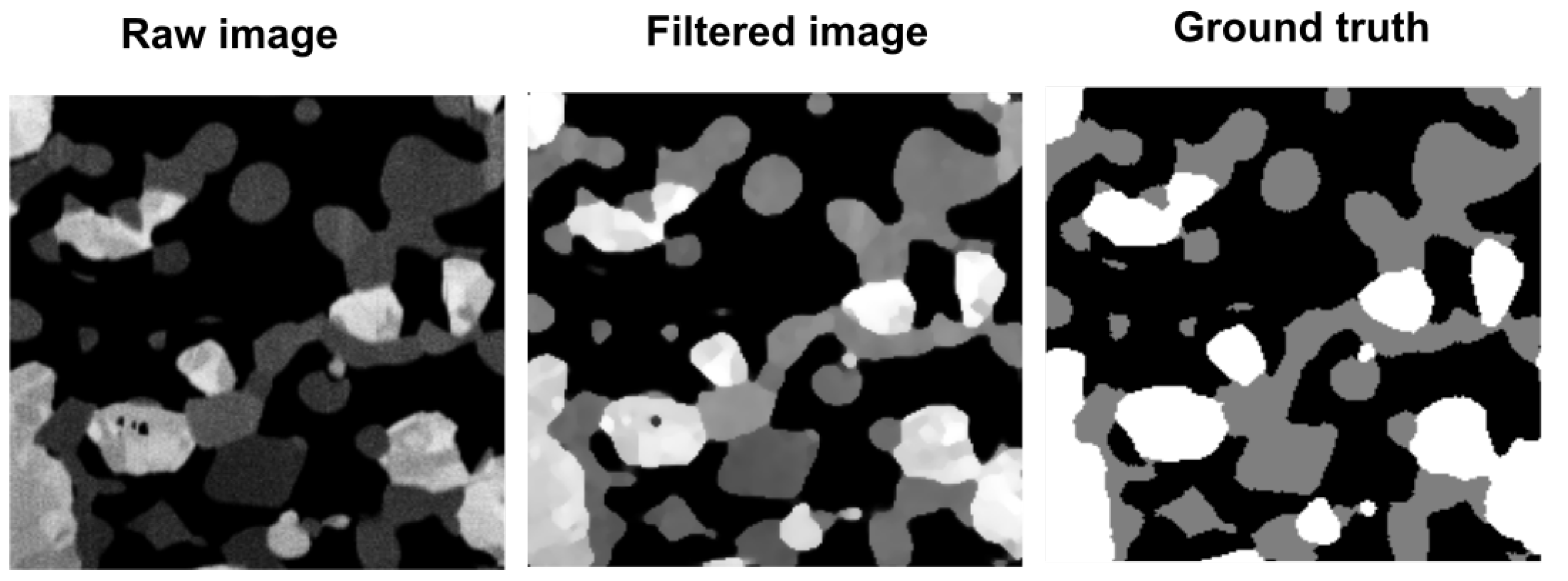
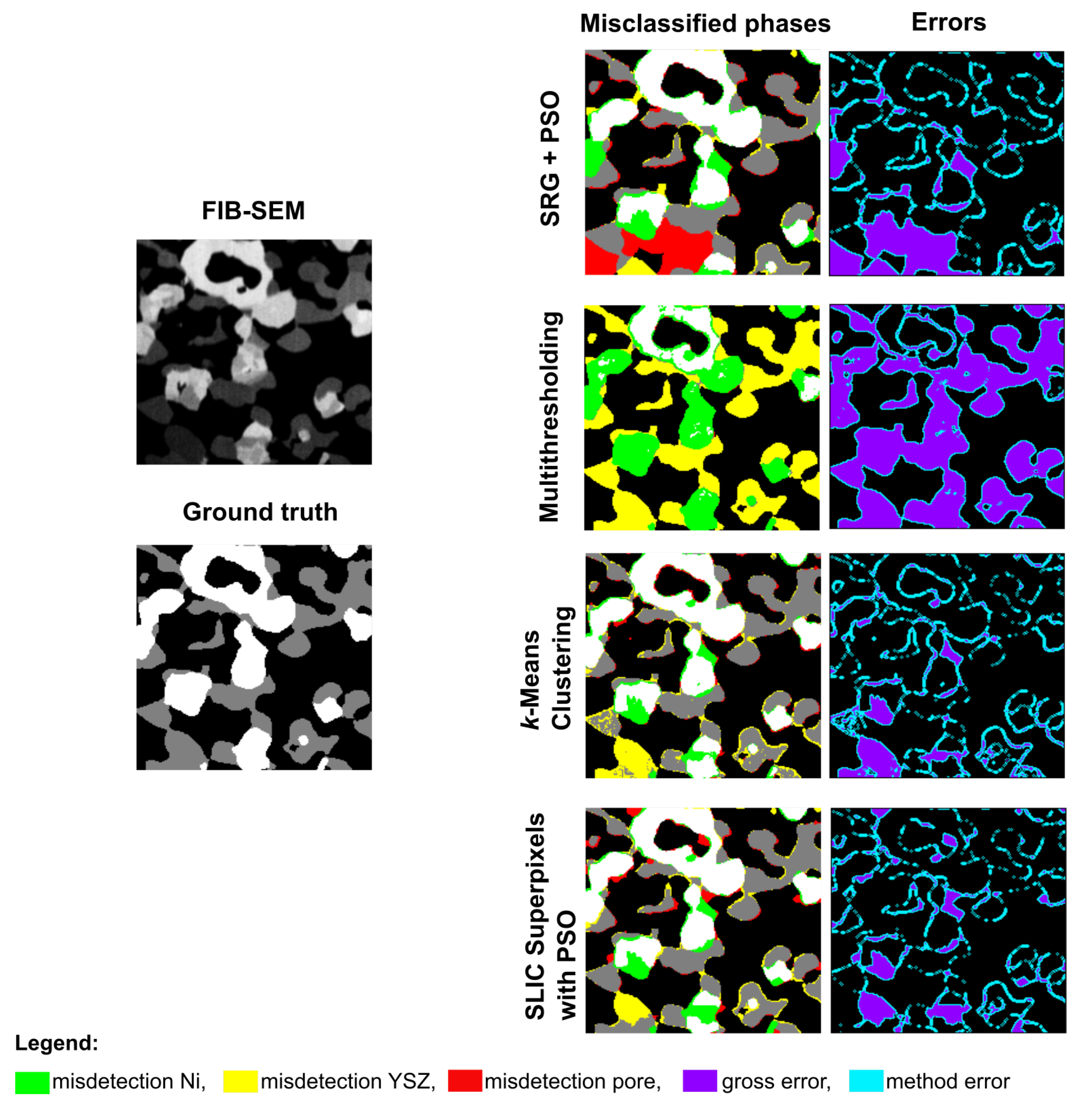
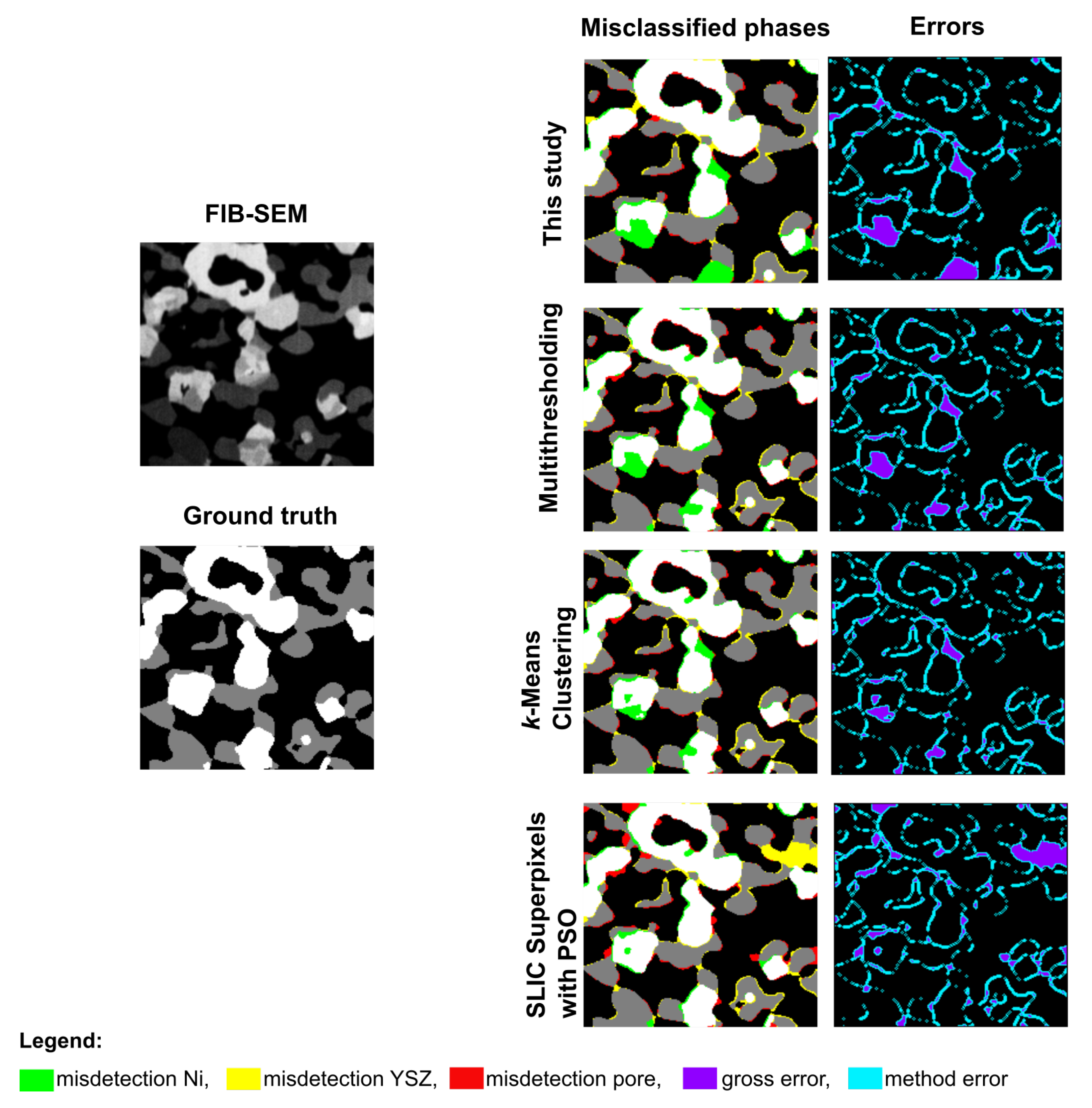
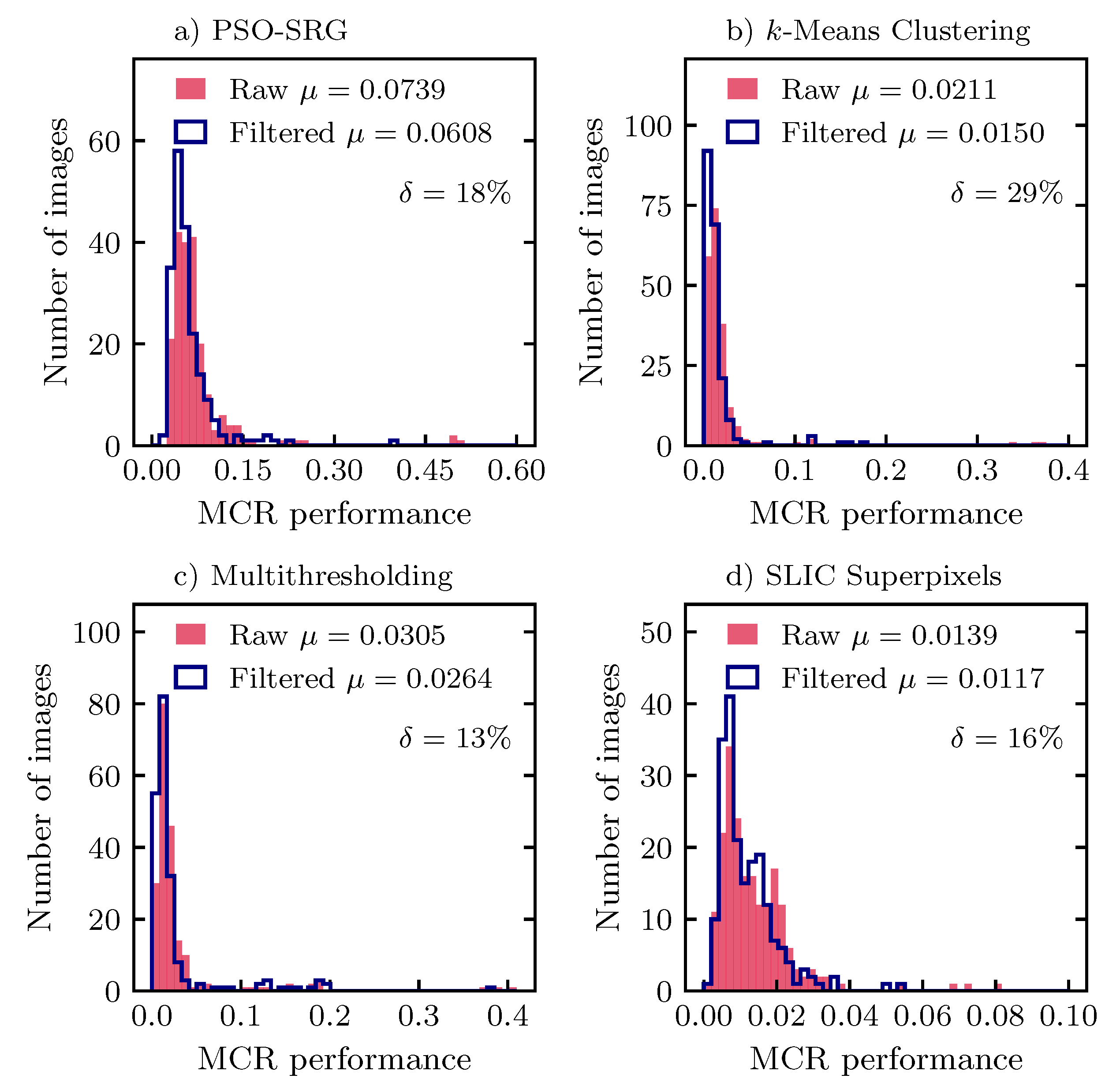
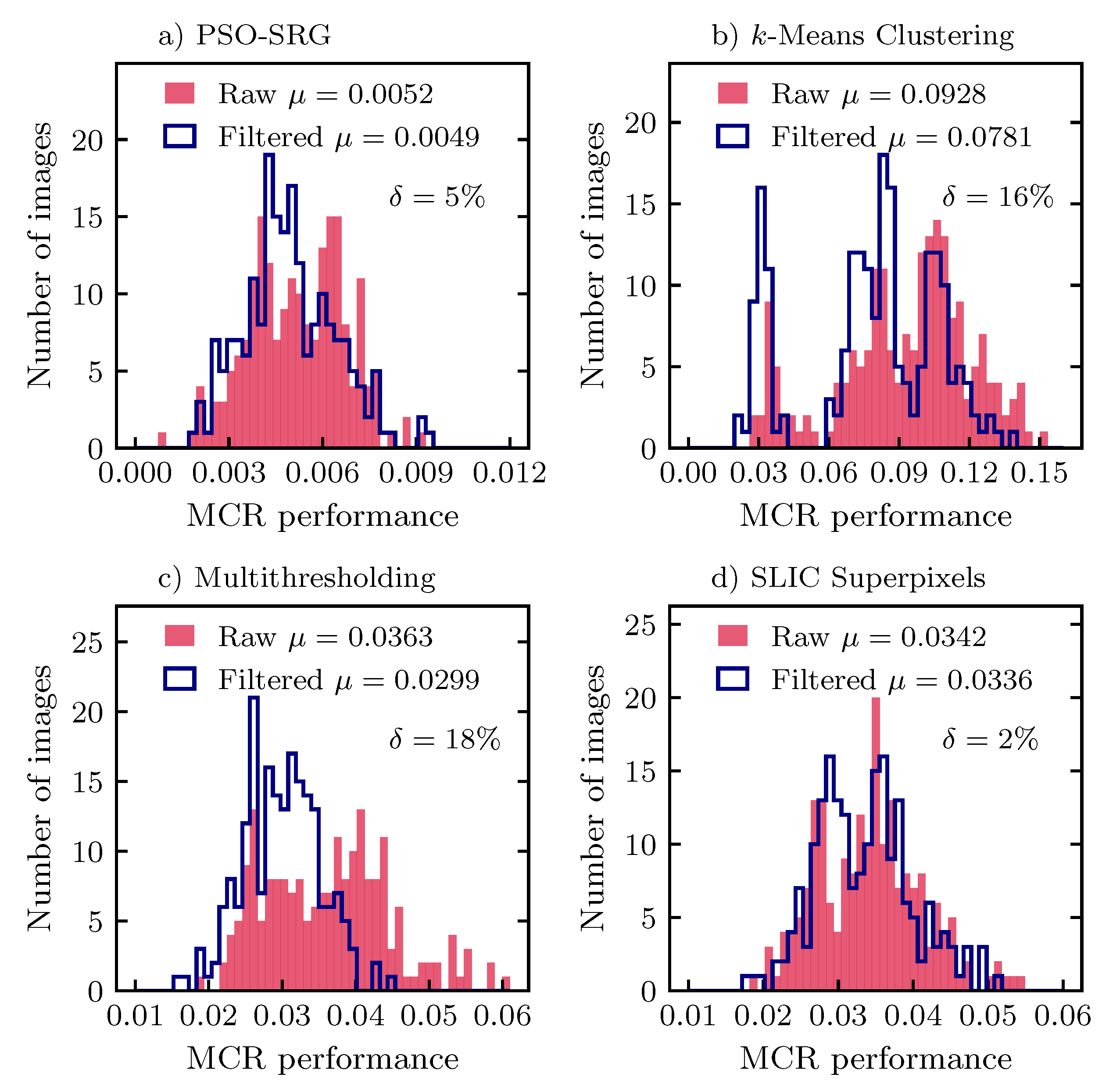
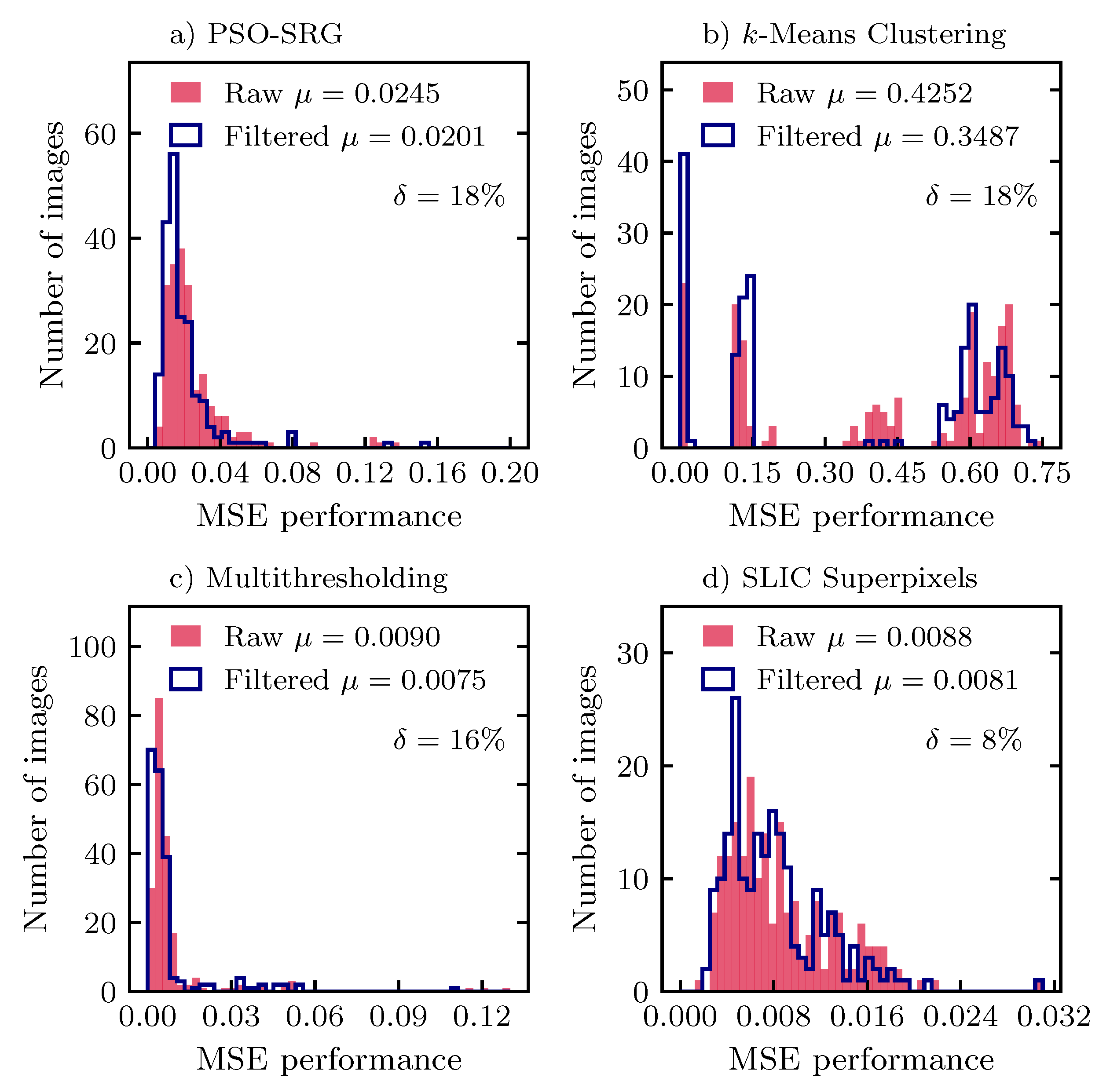
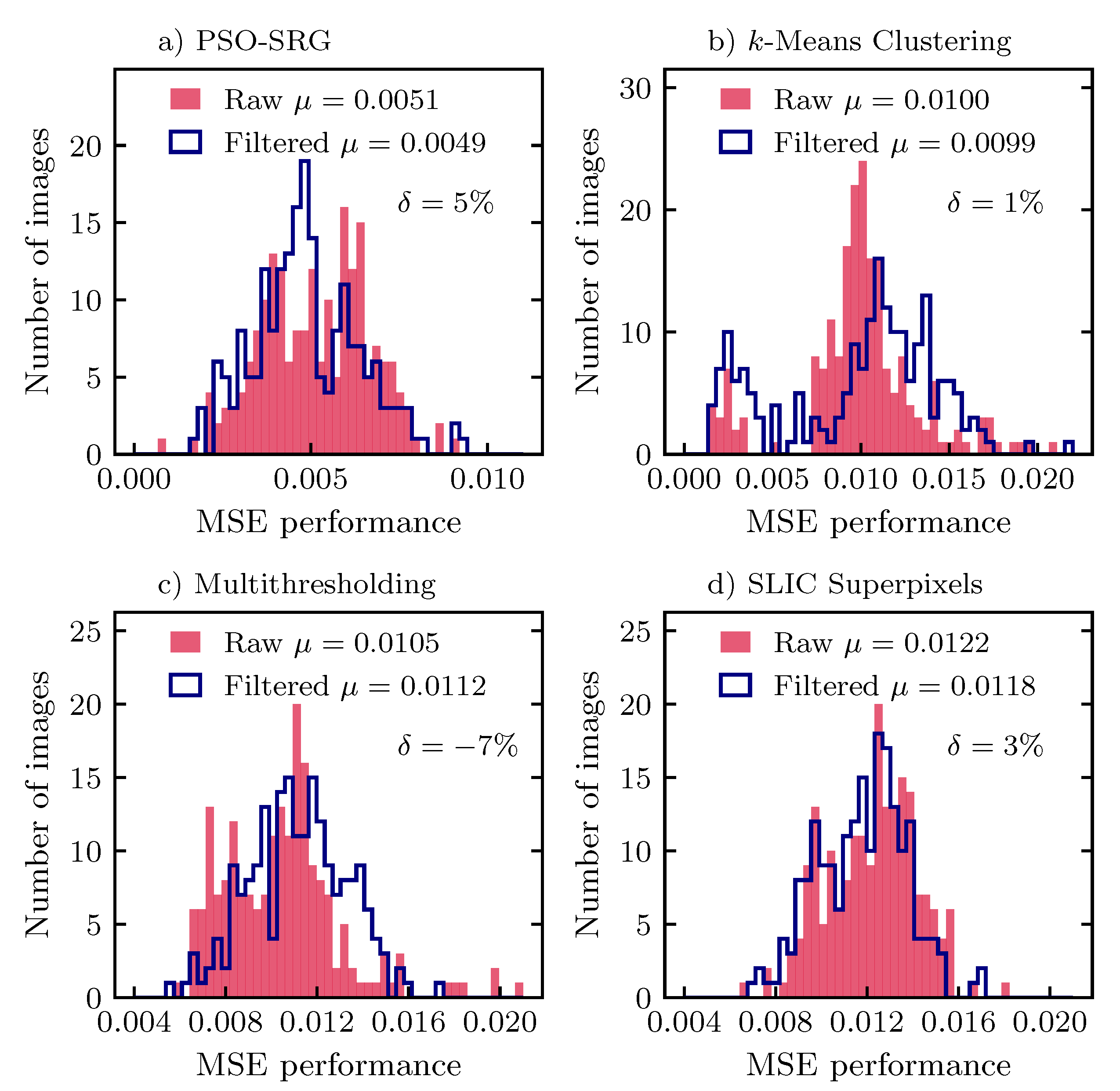

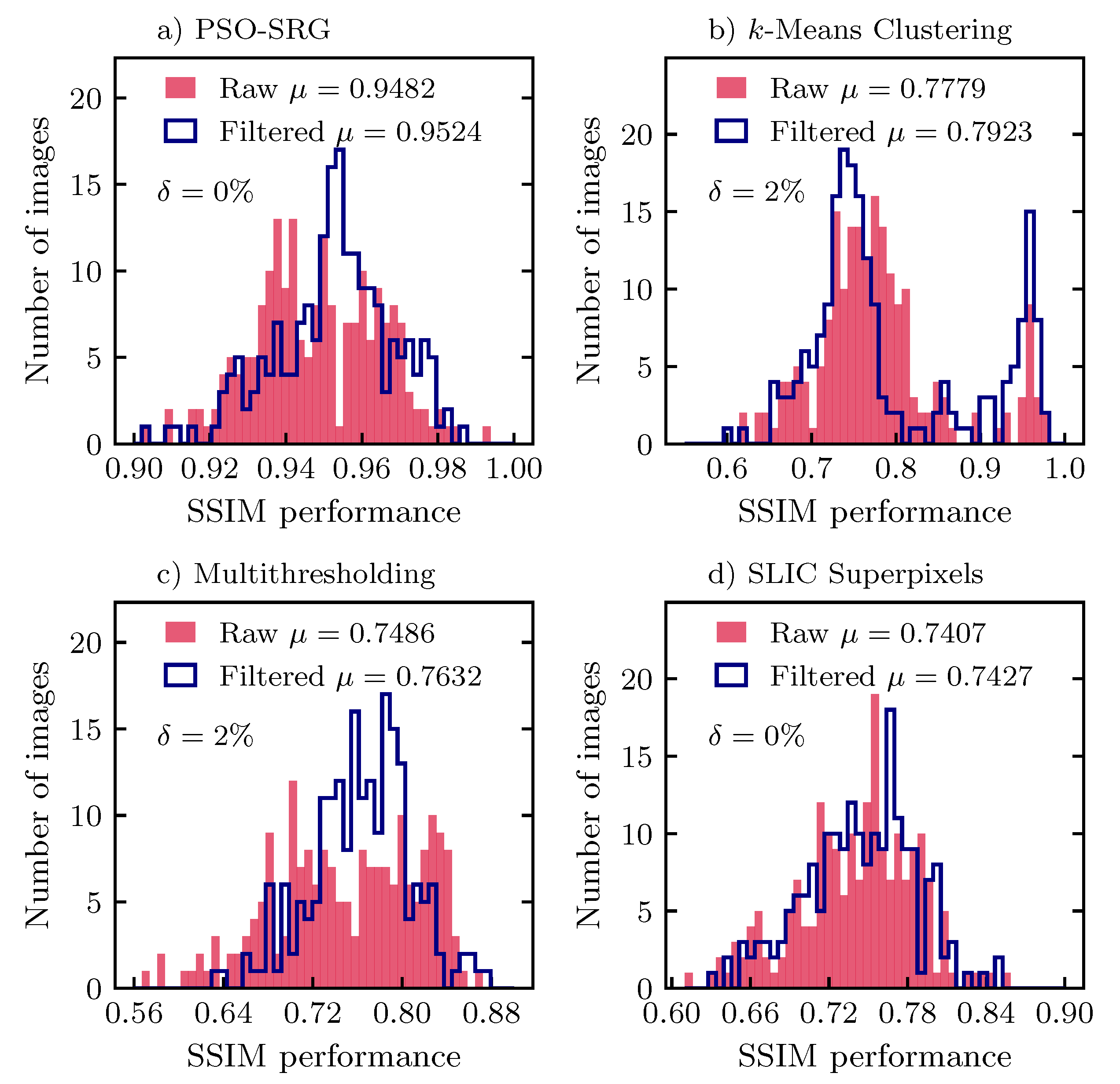
| Constituent | Producer | Content [wt.%] |
|---|---|---|
| NiO powder | fuelcellmaterials, USA | 35.6 |
| YSZ powder | Tosoh, Japan | 31.1 |
| PVB | SigmaAldrich, USA | 3.3 |
| PEG | SigmaAldrich, USA | 10.0 |
| Toluene/Ethanol (60/40 vol.%) | POCH, Poland | 20.0 |
| Filter | Parameter | Ranges | |
|---|---|---|---|
| Adjust image intensity values [38] | gamma correction = 1 (default) | – | |
| Illumination correction [39] | correction factor | 0.001–5 | |
| Kuwahara [40,41] | window size | 1–7 | |
| Homomorphic [42] | order of the Butterworth highpass filter | 0.001–300 | |
| cutoff distance | 0.001–25 | ||
| Edge preserving | Unsharp masking [43] | standard deviation of the Gaussian lowpass filter | 0.001–25 |
| filter strength | 0.001–25 | ||
| Gaussian smoothing [44] | standard deviation | 0.001–25 | |
| Filter | Parameter | Value |
|---|---|---|
| Illumination correction [39] | correction factor | 0.033 |
| Kuwahara [40,41] | window size | 1.03 |
| Homomorphic [42] | order of the Butterworth highpass filter | 0.001 |
| cutoff distance | 0.001 | |
| Unsharp masking [43] | standard deviation of the Gaussian lowpass filter | 24.959 |
| filter strength | 0.001 | |
| Gaussian smoothing [44] | standard deviation | 1.241 |
| Phase | With Filtration | Without Filtration |
|---|---|---|
| Nickel | 0.088 | 0.082 |
| Pore | 0.042 | 0.008 |
| YSZ | 0.127 | 0.091 |
Publisher’s Note: MDPI stays neutral with regard to jurisdictional claims in published maps and institutional affiliations. |
© 2021 by the authors. Licensee MDPI, Basel, Switzerland. This article is an open access article distributed under the terms and conditions of the Creative Commons Attribution (CC BY) license (https://creativecommons.org/licenses/by/4.0/).
Share and Cite
Chalusiak, M.; Nawrot, W.; Buchaniec, S.; Brus, G. Swarm Intelligence-Based Methodology for Scanning Electron Microscope Image Segmentation of Solid Oxide Fuel Cell Anode. Energies 2021, 14, 3055. https://doi.org/10.3390/en14113055
Chalusiak M, Nawrot W, Buchaniec S, Brus G. Swarm Intelligence-Based Methodology for Scanning Electron Microscope Image Segmentation of Solid Oxide Fuel Cell Anode. Energies. 2021; 14(11):3055. https://doi.org/10.3390/en14113055
Chicago/Turabian StyleChalusiak, Maciej, Weronika Nawrot, Szymon Buchaniec, and Grzegorz Brus. 2021. "Swarm Intelligence-Based Methodology for Scanning Electron Microscope Image Segmentation of Solid Oxide Fuel Cell Anode" Energies 14, no. 11: 3055. https://doi.org/10.3390/en14113055
APA StyleChalusiak, M., Nawrot, W., Buchaniec, S., & Brus, G. (2021). Swarm Intelligence-Based Methodology for Scanning Electron Microscope Image Segmentation of Solid Oxide Fuel Cell Anode. Energies, 14(11), 3055. https://doi.org/10.3390/en14113055






